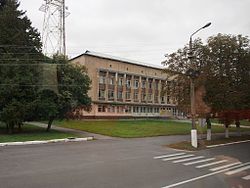Chernobyl
Чорнобиль | |
|---|---|
| Chornobyl | |
 Chernobyl's Old City Hall building | |
| Coordinates: 51°16′20″N 30°13′27″E / 51.27222°N 30.22417°E | |
| Country | |
| Oblast | Kyiv Oblast |
| Raion | Chernobyl Raion (1923–1988) Ivankiv Raion (1988–2020) Vyshhorod Raion (2020–present) Chernobyl Exclusion Zone (de facto) (1986–present) |
| First mentioned | 1193 |
| City status | 1941 |
| Government | |
| • Administration | State Agency of Ukraine on the Exclusion Zone Management |
| Area | |
| • Total | 25 km2 (10 sq mi) |
| Population (2019) | |
| • Total | 1,054 |
| Postal code | 07270 |
| Area code | +380-4593 |
 | |
Chernobyl (/tʃɜːrˈnoʊbəl/ chur-NOH-bəl, UK also /tʃɜːrˈnɒbəl/ chur-NOB-əl; Russian: Чернобыль, IPA: [tɕɪrˈnobɨlʲ]) or Chornobyl (Ukrainian: Чорнобиль, IPA: [tʃorˈnɔbɪlʲ] ) is a partially abandoned city in the Chernobyl Exclusion Zone, situated in the Vyshhorod Raion of northern Kyiv Oblast, Ukraine. Chernobyl is about 90 kilometres (60 mi) north of Kyiv, and 160 kilometres (100 mi) southwest of the Belarusian city of Gomel. Before its evacuation, the city had about 14,000 residents (considerably less than neighboring Pripyat).[1] While living anywhere within the Chernobyl Exclusion Zone is technically illegal today, authorities tolerate those who choose to live within some of the less irradiated areas, and an estimated 150 people live in Chernobyl in 2020.[2]
First mentioned as a ducal hunting lodge in 1193, the city has changed hands multiple times over the course of history. Jews moved into the city in the 16th century, and a now-defunct monastery was established in the area in 1626. By the end of the 18th century, Chernobyl was a major centre of Hasidic Judaism under the Twersky Dynasty, which left Chernobyl after the city was subjected to pogroms in the early 20th century. The Jewish community was later murdered during the Holocaust. Chernobyl was chosen as the site of Ukraine's first nuclear power plant in 1972, located 15 kilometres (9 mi) north of the city, which opened in 1977. Chernobyl was evacuated on 5 May 1986, nine days after a catastrophic nuclear disaster at the plant, which was the largest nuclear disaster in history. Along with the residents of the nearby city of Pripyat, which was built as a home for the plant's workers, the population was relocated to the newly built city of Slavutych, and most have never returned.

The city was the administrative centre of Chernobyl Raion (district) from 1923. After the disaster, in 1988, the raion was dissolved and administration was transferred to the neighbouring Ivankiv Raion. The raion was abolished on 18 July 2020 as part of the administrative reform of Ukraine, which reduced the number of raions of Kyiv Oblast to seven. The area of Ivankiv Raion was merged into Vyshhorod Raion.[3][4]
Although Chernobyl is primarily a ghost town today, a small number of people still live there, in houses marked with signs that read, "Owner of this house lives here",[5] and a small number of animals live there as well. Workers on watch and administrative personnel of the Chernobyl Exclusion Zone are also stationed in the city. The city has two general stores and a hotel.
During the 2022 Russian invasion of Ukraine, Chernobyl was temporarily captured and occupied by Russian forces between 24 February and 2 April. After its capture, it was reported that radiation levels temporarily rose, due to human activities, including earthworks, which disturbed the dust.
- ^ Mould, Richard (2000). "Evacuation zones and populations". Chernobyl Record. Bristol, England: Institute of Physics. p. 105. ISBN 0-7503-0670-X.
- ^ "The people who moved to Chernobyl". www.bbc.co.uk. Retrieved 12 July 2024.
- ^ "Про утворення та ліквідацію районів. Постанова Верховної Ради України № 807-ІХ". Голос України (in Ukrainian). 18 July 2020. Retrieved 3 October 2020.
- ^ "Нові райони: карти + склад" (in Ukrainian). Міністерство розвитку громад та територій України.
- ^ Withington, John (2013). Disaster!: A History of Earthquakes, Floods, Plagues, and Other Catastrophes. Skyhorse Publishing Company, Inc. p. 328. ISBN 978-1-62636-708-1.


